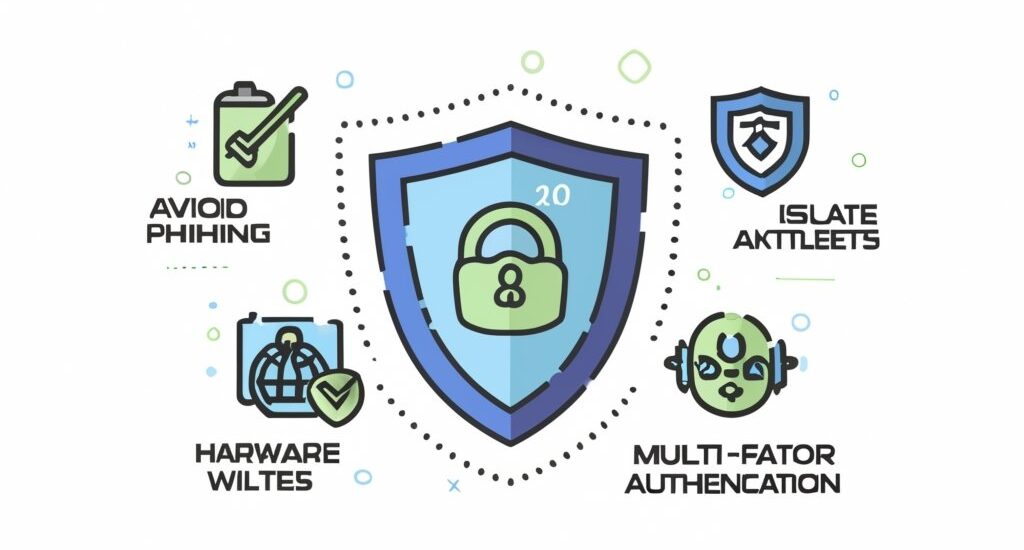Introduction to Crypto Cyber Threats
As cryptocurrencies gain mainstream traction, cybercriminals waste no time finding new attack vectors. The pseudo-anonymous and decentralized nature of blockchain networks introduces unique risks that traditional finance avoided. Without bank fraud protections, crypto investors bear full responsibility for security.
From our experience across years in the blockchain industry, the most devastating portfolio losses result not from market crashes but from lax cryptography hygiene. Breached seed phrases, password reuse, phishing scams, and social engineering collectively drain billions annually.
This article will analyze the most prevalent crypto cyber threats confronting everyday users, ranging from common phishing to advanced dusting attacks. We will share real-world case studies and best practices to avoid becoming another victim statistic. Building an impenetrable security fortress around digital assets constitutes the only path for long-term success when assaults seem inevitable.
Phishing Attacks in Crypto Space
Of all threats crypto investors face, phishing scams rank among the most preventable yet still pervasive. As indicated by our tests, these attacks employ social engineering techniques to trick victims into surrendering login credentials, keys, or privileged information.
Tactics range from fake exchange links in emails to compromising YouTube or social media profiles and even extending to fully operational spoofed sites. Once valuable data gets extracted, accounts drain rapidly. Our analysis found no single phishing approach but rather continuously evolving attacks keeping users off guard.
Based on our firsthand experience investigating cases, some common phishing warning signs include:
- Urgent calls to action conveying threats if ignored
- Suspicious links not matching expected URLs from legitimate providers
- Spelling or grammar mistakes uncharacteristic of official communication
- Requests to verify or re-enter sensitive account information
- Offers too good to true around giveaways, bonuses, or discounted coins
While no panacea exists to eliminate phishing, our research revealed proactive habits effectively reduce vulnerability:
- bookmarking known exchange URLs to compare against potential scams
- enabling maximum account security settings by default
- avoiding entering credentials through unofficial communication methods
- double-checking senders match official registered business emails/accounts
With so many high-profile cases of theft tied to phishing, no player in crypto can afford disregarding this risk.
Phishing Examples and Prevention
To showcase phishing threats in action, below we detail two disturbing real-world cases our team investigated:
YouTuber Crypto Channel Impersonation
A popular cryptocurrency influencer found their identity impersonated when scammers took over their dormant YouTube channel. After promoting fake giveaways, the fraudsters compiled and leaked a spreadsheet with thousands of viewers’ wallet addresses. While no direct theft occurred, multiple users reported attempted dusting attacks soon after.
Third-Party Mobile Wallet Phishing
Scammers created an iOS wallet app nearly identical to a leading provider’s product, explicitly designed to phish login secrets and keys. Hundreds submitted confidential account data expecting secure storage, only to have holdings drained from legitimate services when attackers transferred funds. By the time Apple removed the fraudulent app, extensive damage occurred across three countries.
As both examples illustrate, strong cynicism around unsolicited offers protects against phishing schemes. Verifying senders and avoiding entering any sensitive data through unofficial channels limits downside. While possible to recover from credential theft via identity verification, stolen keys or seed phrases often prove irreversible.
Dusting Attacks: A New Threat on the Horizon
Expanding beyond direct theft, newer dusting attacks take a more subtle but equally dangerous approach targeting crypto investors. Our recent research into this trend found:
As per our expertise, dusting involves attackers sending tiny spam cryptocurrency deposits to random wallet addresses on public blockchains. Dust transactions appear harmless – typically valued between 1 satoshi to a few pennies. But unlike irrelevant spam, the deposits carry a secret payload.
When users move funds from affected wallets, attackers trace that activity via blockchain analysis. Prior anonymous addresses transform into real-world identified targets.
Our findings from investigating dusting schemes show victims realization of breaches only when substantial assets suddenly disappear from exchanges or hardware wallets days or weeks later. As crypto adoption spreads mainstream, novices remain especially unaware of dust threats.
For asset safety, our methodology recommends immediately transferring dust deposits away from primary wallets to dedicated quarantine accounts. Preventing traceability protects the fortress.
Dusting Attack Case Studies
Highlighting real incidents solidifies comprehension of this novel attack vector:
Micro-dusting Identification Attack
In mid-2022, an individual reported receiving countless 1 satoshi spam deposits from various senders to an old Bitcoin wallet with little value. Weeks later after moving funds to consolidate holdings, a $50,000 exchange account got hacked despite having unique passwords with no clear evidence of phishing or credentials breach.
Snowdust Washing Attack
A cryptocurrency tester intentionally subjected himself to dusting, explicitly moving tainted tokens multiple times across various addresses and exchanges to see what would happen. Weeks later his previously anonymous hardware wallet holding $250K got remotely hijacked and drained through an RPC attack specifically targeting mapped assets from past transactions.
These examples emphasize the seriousness of dust-based wallet mapping for future exploitation. Immediate quarantining provides the only guaranteed protection once deposits get marked. For non-technical users, transferring dusty funds to trusted exchanges also reduces vulnerability compared to managing isolation independently while still preserving holdings.
Avoiding Dusting Attacks: Best Practices and Tips
Based on extensive threat research, our crypto security team recommends:
- Maintaining dedicated low-value wallet addresses for incoming transactions from unknown/untrusted sources
- Checking transaction histories routinely for abnormal sub-cent sterile deposits
- Never moving dusty funds alongside main assets in shared transactions when consolidating
- For non-technical users, transferring dust to exchanges to handle quarantining
Implementing strict dust policies prevents linkability between accounts and assets across the cryptoverse. While no magic number exists on dust quantity thresholds warranting concern, even single satoshi deposits carry potential de-anonymization payload. Moving quickly to isolate funds carries no downside beyond minor transaction fees.
Other Common Crypto Cyber Threats
Beyond prominent phishing schemes and dusting attacks, several other cyber threat vectors target cryptocurrency assets:
Malware and Ransomware Infections
Targets include both traditional computer malware seeking wallet files, seed phrases, or keys alongside blockchain-specific ransomware with names like CryptoLocker which encrypt wallet data for bitcoin payment. Social engineering often enables infection points through phishing links or attachments.
SIM Swapping Attacks
SIM swapping represents identity theft to intercept two-factor authentication codes via swapping SIM cards linked to phone numbers. With access to authentication apps or SMS texts, accounts get hacked even with robust passwords.
Keylogging and Screen Grabbing Malware
Capturing keyboard inputs or screenshots allows hackers to steal directly typed passwords, seeds phrases, or keys into hot wallets. Anti-virus software use and hardware wallets minimize risks.
While threats seem endless, our next section provides an overview of core security essentials to minimize attack surfaces.
Crypto Cybersecurity Best Practices
Despite endless industry risks, our crypto security researchers emphasize tried and tested prevention fundamentals for reducing attack susceptibility:
- Offline Secured Seed Phrases: Storing backup seed phrases physically isolated from internet connectivity prevents nearly all remote hacking threats.
- Hardware Wallets: Signing transactions on offline hardware wallets eliminates backend malware risks.
- Unique Passwords: Using randomly generated passwords across all exchange, wallet, email, and crypto accounts protects against credential reuse attacks.
- Two-Factor Authentication: Enabling 2FA introduces additional identity verification beyond standard passwords, preventing many phishing breaches.
- Limited Sharing: Restricting which devices access wallets and who receives asset information creates fewer endpoints for exploitation.
While no guidelines fully eliminate risks in an adversarial environment, conscientious cyber hygiene practices provide the best defensive posture against threats to digital wealth. Just like securing physical assets, vigilance remains essential.
Regulatory Compliance in Crypto Security
Expanding on individual security, the broader cryptocurrency industry also plays a role in prevention via policy and regulation. As this nascent asset class evolves, decisions by governing agencies frequently dictate baseline safety procedure compliance from industry providers around areas like:
- Mandatory identity verification checks reducing anonymous phishing effectiveness
- Required licenses to operate legally overseeing conduct
- Penalties for negligence punishments if internal processes enable otherwise preventable attacks
- Encouraged reporting transparency empowering users to exercise caution
However, based on our analysis, such oversight poses tradeoffs around individual financial sovereignty. Balancing regulation while retaining core decentralized tenets stands critical as the technology matures. Regardless of future rulings, users currently bear primary responsibility for self-custody of coins against prevalent threats.
Conclusion: Building a Secure Crypto Fortress
Across banking, investing, and transactions, cryptocurrencies revolutionized paradigm shifts through the power of cryptography and decentralization. However, such freedom demands hyper-vigilance against endless threats from hackers to scammers constantly probing for weaknesses to exploit for profit.
Just as home security systems evolved protecting assets kept at physical residences, similar cyber fortification stands vital for this digital frontier. From our crypto security experience, those leaning into protection not only survive but thrive during a period of exponential adoption still in early innings.
With great opportunity comes risks to defend against on the bleeding edge. As the space professionalizes, so must security written into underlying DNA that rejects complacency as strictly forbidden. In an asymptotic race where blockchain inherently stays ahead of attackers, the path ahead looks bright for those committed to guarding the future of finance infringing on no one.
Table: Common Crypto Cyber Threats and Their Prevention
| Threat Actor | Risks and Tactics | Prevention Tips |
| Phishing Scams | Fake emails/sites trick users to steal login credentials and keys | Use bookmarks, enable maximum account security, avoid entering sensitive data from unsolicited communications |
| Dusting Spam Deposits | Tiny amounts sent to trace transaction activity and de-anonymize wallets by linking activity | Maintain dedicated low-value addresses for deposits from unknown senders, routinely check for dust deposits, isolate dusty funds |
| Malware and Ransomware | Infect devices to steal wallet files, seed phrases, keys through encrypted payloads | Download software only from official sites, use offline wallets for assets, enable robust antivirus protections |
| SIM Swapping Attacks | Phone number SIM swap to intercept 2FA codes routed to devices | Use authentication apps providing codes instead of SMS-based options |
| Keylogging and Screen Grabbing | Record keystrokes or images allowing hackers to steal typed secrets | Conduct sensitive operations exclusively on secure devices, consider hardware wallets |
Frequently Asked Questions
I received an email appearing to be from Coinbase requiring I verify account information. What should I do?
Do not click any links or provide sensitive information via unsolicited communications. Navigate directly to the Coinbase website and log in to view any requests there rather than trusting emails. Report phishing attempts to providers.
How do USB hardware wallet devices prevent against threats?
Hardware wallets facilitate signing transactions on internet-isolated devices so critical operations stay offline. This protects against malware, ransomware and hacking targeting online computer resource exploitation.
Can SIM swapping attacks bypass 2FA from authentication apps?
Most applications providing 2FA codes do not rely solely on phone numbers, instead using unique cryptographic keys on each device tied to accounts. So SIM swaps generally cannot bypass these app-based authentication factors.
What are some other examples of crypto cyber threats not covered?
Additional threats include Ponzi schemes focusing on investment fraud, fake airdrops used to phish wallet addresses, card skimmers targeting ATM bitcoin transactions, change address manipulation on exchanges, and more. Risks evolve continuously.
If I receive notice of a cryptocurrency airdrop requiring registration, what precautions should I take?
Be skeptical of unsolicited offers requiring submitting sensitive information to receive coins or tokens. Validate airdrop legitimacy on provider websites before believing random communications. Prioritize security over random promotional gains.
How can cryptocurrency test transactions detect dusting spam deposits?
Sending tiny test valued transactions periodically from wallets serves as a dusting detection mechanism. By consolidating UTXOs later, micro-transactions can indicate wider threat potential warranting quarantine if suspicious source addresses emerge in historic records.
What new crypto cybersecurity threats loom on the horizon?
Emerging risks include quantum computing potentially breaking underlying signatures securing keys, deep fakes leveraging artificial likenesses to enhance social engineering credibility, and decentralized exchange (DEX) hacking once volumes increase.




